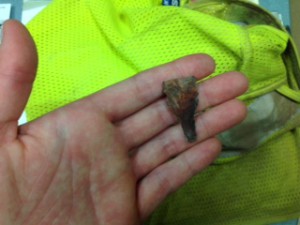This past summer, I had the opportunity to take a paid internship working on the PHAST crew. The internship is available through a partnership between IUP and PennDOT. I worked as a tech on a crew of 4 – we cruised around the state digging holes for small projects (mostly bridge replacement projects), met a bunch of the district archaeologists, helped out with the Byways conference this past July in Philly and learned and networked like crazy – a great opportunity for experience with CRM working on projects from start to finish. Now that the fieldwork part of PHAST is over and I’m crying into my keyboard, a few questions have been popping up again and again as we work through report writing. Things like:
“Why are we calling this trash a site?”
“Why does this site have three different names?”
“Sooo, a multi-component site can be completely separate sites horizontally as long as they cover at least one point vertically? Even if they have separate living surfaces?! WHYYY??!!!”
Ok, the second question was partly my fault – Apparently the whole crew started making up their own names for a site partway through excavation. Luckily we all had the sense to keep the State Route (SR) number the same… And we worked on small enough projects this summer that it wasn’t disastrous. Still, it was enough to remind us how important it is to take care in writing site info on your artifact bags.
But, sites can sometimes have different names – or at least different survey or report names for separate investigations. This can be confusing when conducting background research for archaeological work, especially when using Cultural Resources Geographic Information System (CRGIS) – Environmental Resource (ER) numbers will usually be the same in this case while reports for different investigation may include different letter distinctions tacked onto the end of the ER numbers. This would have been helpful knowledge to me as a first year working with CRGIS for the first time. (CRGIS is maintained through The Pennsylvania Historical & Museum Commission – PHMC – It is worth familiarizing yourself with the program)
“Why are we calling this trash a site?”
States give guidelines on how many flakes may count as a site versus an isolated find – but what about historic fill episodes? Or an historic trash heap? What about all of that Budware* mixed into your STP, mixing in with that dateable transfer print whiteware? Does that count as a site?
Well, as Tom King likes to put it – it depends. Some folks will determine whether the fill they encounter is primary or secondary before they decide whether to call it a site or not. Does the fill contain Budware or other modern trash like candy bar wrappers? Can you determine whether the fill was part of a road construction event or a small historic deposit or household trash? What would that look like archaeologically?
Sometimes archaeologists will still butt heads over whether findings represent a site or not – Is it better to record that some historic artifacts were found off the side of the roadway or is it better to say that since those artifacts were ‘insignificant’ or did not represent a site that there was nothing there…? And if you do say there was a site, how much of that Budware and plastic ends up being curated along with the historic artifacts? How much curation room are we willing to set aside for trash heap sites? Will that Budware ever be studied? What about all of the Budware and modern junk that gets tossed? Does anyone out there have strong feelings about this?
As for multicomponent sites, Dr. Ford, can you please explain this to me?! For some reason, I was under the impression that a multicomponent site meant that there were different temporal components represented on the same living surface…. Did I sleep through a lecture at some point? Do you or anyone else find this infuriating or confusing? This means that a ‘multicomponent site’ could have two completely different site boundaries. Or more! AAhhh!!!
Please share your thoughts and feelings – I know Dr. Sarah’s Laws and Ethics class will discuss some of these topics, and I would love to hear some of the discussion.
*We lovingly refer to those fragments of modern beer bottles, chucked out of car windows on the side of the road, and found throughout your STP as ‘Budware’ (as in Budwiser… )
—————————————————————————————————————-
ALSO – As part of a mini-series that I hope to expand – I bring you:
“MUNSELL EVERYTHING”
Here we use Munsell as a verb. I will share with you some of the things that I have Munselled for kicks – PLEASE SHARE SOME OF YOURS!!!
My cat, James Brown: GLEY 4/N – dark grey – And she is a silty loam (more like a salty loaf!)
My coffee from Common Grounds this morning: 10YR 5/4 – yellowish brown
Captain Jean-Luc Picard’s Starfleet uniform: 5R 3/8 – dark red (Kirk’s is like a 5Y 6/3 or so – Its a tough call – what do you folks think?)
![IMG_1784[1]](https://iblog.iup.edu/trowelsandtribulations/files/2014/09/IMG_17841-1x6g8yc-300x200.jpg)


